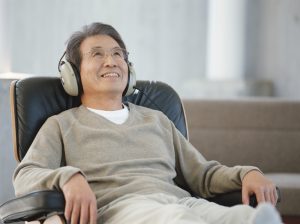 Stress has a way of upending our lives—it can cause tension in our relationships, anxiety in our thoughts, and tightness in our bodies. You may have a self-care practice in place, or yours may need some shoring up.
Stress has a way of upending our lives—it can cause tension in our relationships, anxiety in our thoughts, and tightness in our bodies. You may have a self-care practice in place, or yours may need some shoring up.
Either way, mindful music listening can be a wonderful way to reduce your stress and reconnect with your body and breath. Mindfulness—the practice of being in the present moment—can be practiced at any time and anywhere. I often use mindfulness exercises with people in therapy as a way to tune into their body, breath, and mind. Mindfulness is not about having an empty mind, but simply noticing whatever is there, thoughts and all.
However, if you find mindfulness challenging (or haven’t tried it!), the addition of music can help you stay focused, while simultaneously helping you to connect with music as a source of strength and creative energy. Music can be a powerful way to experience the present moment.
Take a moment to think about the music in your life. Do you listen to music regularly? Is it live music? Recorded music? What kind of music moves you? Helps you relax? Energizes you? Do you play an instrument or sing? What music do you hear around you (perhaps music your kids or partner listen to)?
Now think about your relationship with music for a moment. Is it a source of frustration or a joy? Do you feel disconnected from music sometimes? Does music soothe you when nothing else seems to work? Do you have a lot of music on your phone but never listen to it?
Whether you listen to music all the time or rarely, mindful music listening can help you slow down and be in the moment. Here’s how:
- Choose a piece of music to listen to. I usually use instrumental pieces, as lyrics can add a whole extra layer, but it’s up to you. It can either be a familiar or unfamiliar piece (it’s interesting to repeat this exercise with the opposite of what you choose this time, just to notice if anything feels different).
- Take a moment to breathe and ground yourself—no matter where you are, or what’s going on around you. Inhale gently through your nose, and exhale deeply through your open lips. Notice your body, and tune into how it feels, whether you’re standing, sitting, walking, or laying down. Just notice any physical structures your body is touching (the floor, the chair, or your shoes) as well as any physical sensations (tightness, tension) in your body.
- Just listen. Use headphones or earbuds if that helps you focus or shut out external noise. Give yourself permission to only listen to the music, without simultaneously checking your email or refreshing your Facebook feed. If it helps, close your eyes (if that’s challenging, it’s likely because you really need the break!).
- Notice. Let yourself be aware of anything you notice, without judgment or self-criticism. Notice the pace of the music, the sounds of the different instruments, or the shifts in volume. Notice if you’re more aware of a certain part of your body as you listen (i.e., “I often feel vibrations of cello music in my chest”). Notice any thoughts or feelings that come up—perhaps the music is connected to a memory, or perhaps an anxious thought is trying to pop through. Let any thoughts just pass through your awareness, and then gently bring yourself back to the sounds of the music.
- Reflect. Take a moment to breathe and check in with your body, breath, and mind (see step 2). Does anything feel different? Do you notice any shifts after listening to the piece of music? Do you feel calmer? If the piece you chose didn’t feel like a good fit, what might you look for in another piece (i.e., slower, fewer instruments, louder)?
This short mindfulness experience can be a useful thing to practice daily, much like meditating. You might experiment with different types of music as a way to notice different responses. You may also find that repeating the same piece of music is a sort of touchstone, a way to continually reconnect to that place inside where gentle pausing and noticing can happen with ease.
I’d love to hear what piece of music you chose to listen to. Feel free to leave a comment below.

The preceding article was solely written by the author named above. Any views and opinions expressed are not necessarily shared by GoodTherapy.org. Questions or concerns about the preceding article can be directed to the author or posted as a comment below.


 Heartbreak and Healing: Why We Love Breakup Songs
Heartbreak and Healing: Why We Love Breakup Songs Music to Heal the Mind, Heart, and Body
Music to Heal the Mind, Heart, and Body Mindfulness, Not Mindlessness: Why Meditation Isn't Selfish
Mindfulness, Not Mindlessness: Why Meditation Isn't Selfish

Please fill out all required fields to submit your message.
Invalid Email Address.
Please confirm that you are human.
Leave a Comment
By commenting you acknowledge acceptance of GoodTherapy.org's Terms and Conditions of Use.